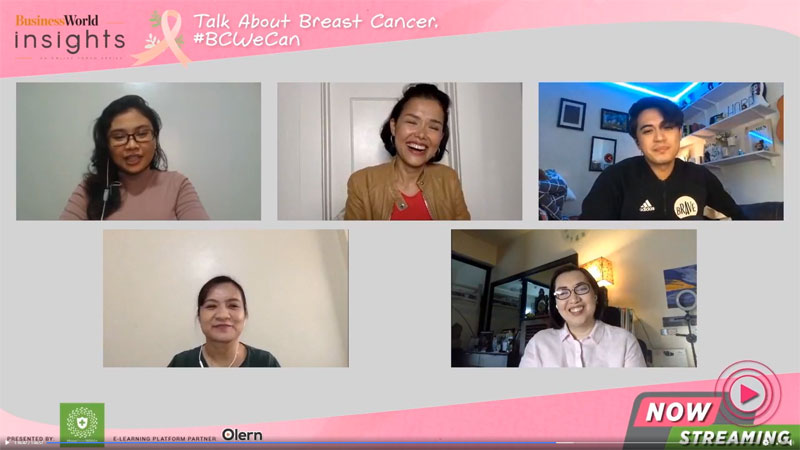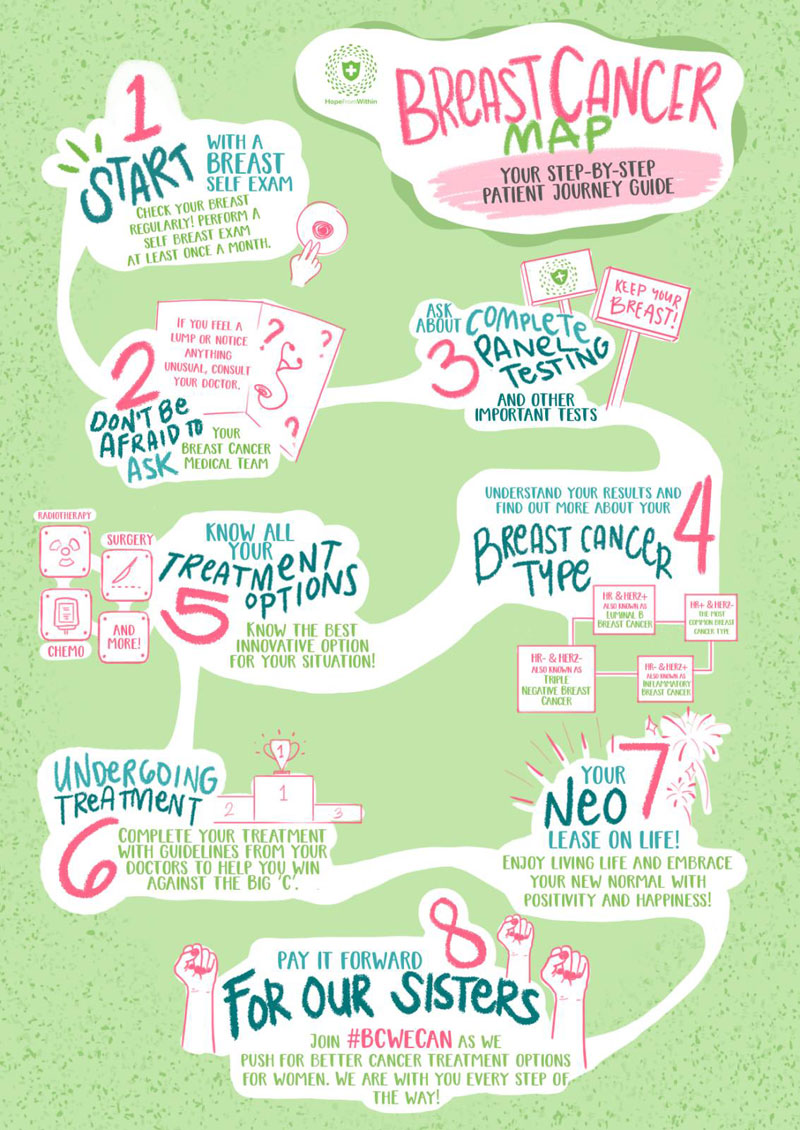Inspiring stories from survivors, caregivers in recent BusinessWorld Insights

One of the biggest cancers affecting women is breast cancer. Once abnormalities afflict the breast, the cancer can be the greatest challenge women will ever face as it affects them beyond the physical and individual aspects. Nevertheless, there is no reason for breast cancer patients to lose hope and stop fighting.
These were among the many musings from the recent BusinessWorld Insights on breast cancer, with the theme “Talk About Cancer, #BCWeCan”. The online forum, held last September 28, highlighted inspiring stories from both breast cancer survivors and caregivers to breast cancer patients.
Dr. Meredith Garcia-Trinidad, a consultant medical oncologist and the multimedia committee head of the Philippine Society of Medical Oncology, briefed on what breast cancer is and how it can be treated.
She pointed out that breast cancer begins with the abnormal growth of cells, followed by its spread.
Most commonly, breast cancer can begin either in the milk ducts of the breast or the lobules of the breast.
The most common sign to watch for is the breast lump, which sometimes gets detected unintentionally, Dr. Trinidad continued. Breast cancer can also show in the lymph nodes in the armpits, as well as in abnormal nipple discharge and skin changes like peau d’orange (skin looking like an orange’s skin) or an inflamed lump or mass.
The oncologist advises that when such conditions are felt they should see a doctor immediately since that is the only way for them to determine whether they have breast cancer.
Dr. Trinidad stressed that treatment of cancer nowadays employs a multi-disciplinary approach, wherein doctors offer patients different options, all of which go together in order to make the treatment more successful.
The combined treatment options may be overwhelming for patients, she observed, but she always points out that they must undergo all those procedures for breast cancer to be effectively treated.
She uses an illustration of an ‘akyat bahay’ to help her patients understand this, with the treatments regarded as the walls of the house, and breast cancer the burglar. “If a treatment is missed, it’s like a break in the wall, wherein cancer can penetrate easily,” she explained in the vernacular. “That’s how I usually convince my patients that they really should mag-undergo all the treatments.”
Battling forward
Inspiring stories were also shared in the forum by breast cancer survivors. Dr. Gia Sison, the Philippine leader of Livestrong Foundation and national adviser at Youth for Mental Health Coalition, recalled that she underwent a mastectomy and six cycles of chemotherapy.

During the grueling process, in particular the scans, she felt anxiety. “There’s always this pending feeling, thinking, ‘What if on one of those scans, it came back? Am I ready for another diagnosis?'” Dr. Sison recalled.
What kept her going was the support of family and friends who have listened to her as she becomes vocal about her situation. “I learned the power of speaking up about the things I might even speak for them,” she added. “And it highly helps when people pray for you and support you.”
Meanwhile, for TV personality Jaymee Joaquin, a four-time metastasized breast cancer survivor, her journey with breast cancer has been of a roller-coaster kind—jumping from one type of treatment and combination of medications to another.
“[My medical team and I were] in a rat race of just being two steps ahead of cancer. With every routine, when we discover something, we switch,” Ms. Joaquin shared.
In fact, many were surprised when she stayed alive even when in one of the routine scans she was found to have a litter of liquid around her heart and left lung. “I’m grateful everyday for God because that was a very, very, very, very close encounter to death,” she said.
Aside from the support both from her family here (albeit virtually) and her peers in the United States, her willpower has greatly driven her to survive. It was having a positive mindset—an attitude of living in the moment and of wanting to stay alive — that kept her going.
“People should ask themselves how badly they want to live, [as if] cancer’s only a mind battle. You have to learn how to twist things around your head,” she shared.
Likewise, it was a ‘one day at a time’ mentality that kept Dr. Sison holding on through her battle with breast cancer, making her appreciate even the most minute details of life.
“When I wake up, the things I disregarded before — like the sunrise, sunset — now as a survivor, it’s a bingo for me to see them,” she explained.
Some of the lessons Dr. Sison learned from her experience with cancer is being patient with the process and not taking her health for granted.
“Before cancer, I’m too much of an autopilot—always work, never resting. But after cancer I learned the importance of self-care, the importance of setting boundaries for yourself,” she added.
Ms. Joaquin, meanwhile, emphasized as well the value in appreciating life, even when something drastic like cancer comes in. “It’s not your fault if you get cancer…It’s sometimes just the randomness of life,” she said. “You just need to roll with the tides, roll with the punches.”
It is also time for the Filipino culture to learn how to support cancer survivors, she added.
“We don’t need a pity party all the time. We don’t want you to look worried if you meet us… Just treat us like normal, how we project [ourselves] to you,” she said. “I think it will help a lot of survivors live long if they are in a very supportive environment.”
Ms. Trinidad agrees with the cancer survivors that having strong willpower and a positive perspective will help a lot in dealing with cancer. “Focusing on negative aspects will not change things, but if we strengthen ourselves, with the support of the family, somehow we can deal with cancer easier,” she encouraged.
A loved one’s strength
The forum also gleaned experiences from a loved one of a cancer patient. Marlo Mortel, another TV personality, lost his mother last August after long bout with breast cancer.
He realized that the battle of relatives whose loved ones battle breast cancer is depressing as well, and so a strong support system is also crucial.
Thankfully, Mr. Mortel recalled, his mother was “such a fighter, and she fought a good fight”, that’s why her family did not give up as well.
He added it was during this period in his life when his purpose in life was further clarified, especially when he expressed his struggle in a song for her mother.
“Actually many have messaged that they have drawn inspiration from that song, and I’m just happy to help,” he said. “Throughout that course, I found my purpose, and that is to help people and inspire people.”
What he learned the most from his experience is that when the inevitable has to happen, it will. “I know it’s hard to say you should not worry, but God is in control, and our worries actually don’t help; it rather adds to our problems,” he said.
He also encourages loved ones to share their struggles. “Don’t be shy to tell people about your situation, because admitting your weaknesses, being vulnerable, it’s not a sign of weakness,” he said. “It’s a sign that you are strong, that you admit that you can’t do it on your own.”
BusinessWorld Insights: “Talk About Cancer, #BCWeCan” was presented by Hope from Within with the support of e-learning platform, Olern.
For guide on how you can best navigate your patient journey and to be part of the Hope From Within community where you can get up-to-date information and patient journey maps, share your stories and experiences of hope and get access to resources from the Philippine Society of Medical Oncologists (PSMO), follow Hope From Within’s FB page: https://www.facebook.com/Hopefromwithinph and visit the Hope From Within website at https://hopefromwithin.org/.




